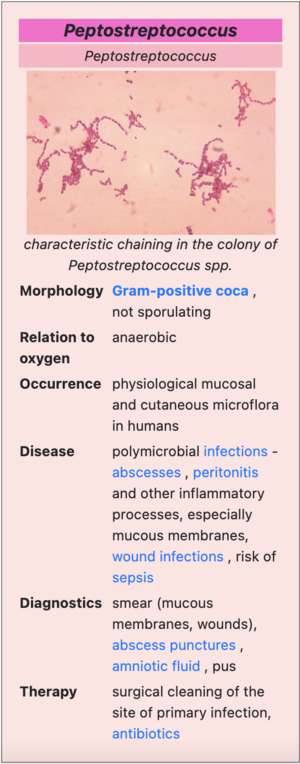Peptostreptococcus
Peptostreptococcus is a genus G+ (Gram stain) non-sporulating anaerobic cocci. They occur as a physiological microflora of the skin, mucous membranes of the gastrointestinal tract, oral cavity and genitals. On their own, they usually do not cause diseases, on the contrary, they typically cause them mixed polymicrobial infection of endogenous origin with the formation of abscesses, peritonitis and wound infections. For the development of the disease, reduced redox potential of the hypoxic (hypoxia) tissue due to injury, vascular supply disorder, tumor, etc. is necessary.
Pathogenicity[edit | edit source]
Bacteria genus Peptostreptococcus are oral pathogens periodontitis and peritonsial abscesses. When aspirated into the airways, they can also cause sinusitis, otitis, pneumonia (up to necrotizing) and pulmonary abscess. They also cause labor endometritis and other inflammatory processes in the small pelvis, often followed by bacteremia and sepsis.
Combined with Streptococcus pyogenes and Staphylococcus aureus (STAU) evoke anaerobic streptococcal myonecrosis clinically similar Clostridium myonecrosis, but with a slower course. Muscle tissue is edematous with purulent, foul-smelling effusion and gas production. The highest pathogenicity show Peptostreptococcus magnus, Peptostreptococcus anaerobius and Peptostreptococcus asaccharolytius. They are also the most common members of this genus isolated from clinical material.
Peptostreptococcus spp. are sensitive to antibiotics, most to penicillin, polypeptide ATBs and cefoxitin. Other bacteria involved in the infection must be taken into account when assessing ATB.
Diagnostics[edit | edit source]
Diagnosis is determined from amniotic fluid, pus, abscess punctate and swab (for example from a wound), when we collect biological material anaerobically. They are cultivated on soils with low redox potential (VL-agar) in anaerobic conditions.



